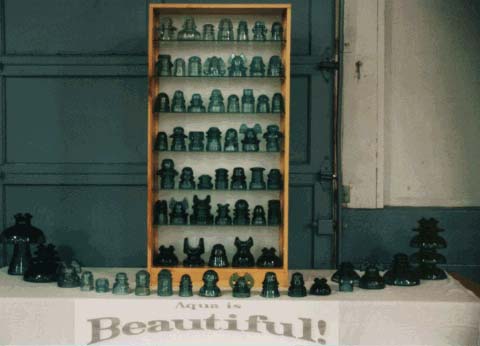
| Row 1 | Row 2 | Row 3 | Row 4 |
| Row 5 | Row 6 | Row 7 | On Table |
Many people who collect insulators specialize in some of the striking colors that they come in -- ambers, blues, greens, yellows, carnivals, and more. I specialize in the beauty of aqua. Aqua is certainly one of the more common of insulator colors, but it comes in a vast array of hues, shades, tints, and tones. It runs from almost blue, to not quite green, and can be so light as to appear almost clear, or so dark as not to be able to see through.
The color of any piece of glass depends on the materials from which it is made, most usually a mixture of silicates such as sand, an alkali such as potash or soda, and another base such as lime or lead oxide. Other materials are also added for various purposes -- to lower the melting point, to strengthen the glass, or to change the color. For example, manganese will make the glass clear or purple; selenium will make it yellow. In production, broken pieces of glass, called cullet, are also a necessary ingredient, and, when used in sufficient quantity, can also have an influence on the color of the end product.
The color aqua is caused by iron, commonly present in the quartz sand used as the main ingredient in glass. The more iron, the darker the resulting aqua. As long as the manufacturer did not add a colorizing agent (and frequently they did not care about the color), the final color would depend mainly on the cullet used. If a sufficient quantity of colored cullet was used, it would alter the final color. Otherwise, the glass would be some shade of aqua. Fairly often, when colored cullet was used but not thoroughly mixed, streaks of the cullet color appear in the insulators.
Now, given all that, aqua can still be a rather ambiguous term. Different people see colors differently, and the same insulator can appear to be different colors under different lighting conditions. In addition, trying to determine the point at which "not quite green" actually becomes green, or "almost blue" becomes in reality blue, can be quite difficult, and open to much interpretation. Some might consider a couple of the insulators displayed here to be green, not aqua, and several could be called blue. I call it all aqua, and I enjoy each and every different shade. Some of my favorite colors here are: the CD 199 (4th row from the top, far right) in a brilliant, blue aqua; the CD 202 (top row, far left) in a pale, ice aqua; the CD 130 (3rd row from the top, 3rd from the right) in a nice, bubbly aqua; the CD 103 (3rd row from the top, 2nd from the right) with its heavy, amber streak; and the CD 258 (2nd row from the bottom, 2nd from the left) in a darker, more green, aqua. Aqua really is beautiful!
In the light case (from top to bottom, left to right):
Row 1: Row 5:
CD 202 Hemingray - 53 CD 196 H.G. Co
CD 180 Liquid Insulator CD 150 Brookfield
CD 115 Whitall Tatum Co. No 3 CD 137 Hemingray D-990
CD 145 G.N.W. Tel. Co. CD 117 &
CD 110.5 Nat. Insulator Co. CD 162.1 Brookfield
CD 119 W. Brookfield 45 Cliff St NY CD 175 Hemingray - 25
CD 105 No Name CD 135 Chicago Insulating Co.
Row 2: Row 6:
CD 265 Fisher Electric Railway CD 141 No Name
CD 102 W. Brookfield 45 Cliff St NY CD 258 Cable
CD 127 H. Brooke's CD 266 Patented June 17, 1890
CD 181 No Name CD 251 N.E.G.M. Co.
CD 259 Cable CD 205 Hemingray No 55
CD 131 W. Brookfield 45 Cliff St NY CD 160 Hemingray No 14
CD 158 Boston Bottle Works CD 123 EC&M Co S.F.
Row 3: Row 7:
CD 143 Canadian Pacific Ry CD 225 Brookfield
CD 133 W. Brookfield New York CD 267 No 4 Cable
CD 287.2 W. Brookfield CD 211 Brookfield No Leak
CD 156 American Insulator Co CD 254 No 3 Cable
CD 109 Chicago Insulating Co CD 299 Brookfield
CD 130 Cal. Elec. Works
CD 103 B
CD 114 Hemingray No 11
Row 4:
CD 110 Brookfield
CD 200 No 2 Transposition
CD 185 Hemingray No 95
CD 125 Hemingray No 15
CD 159 F. W. Gregory
CD 257 Hemingray
CD 199 Prism
On the table (left to right):
CD 303/310 Hemingray Muncie Type CD 285 No Name
CD 249 Hemingray No 0 Provo Type CD 262 No 2 Columbia
CD 308 No Name CD 151 H.G. Co. Petticoat
CD 120 Pat. Dec 10 1871 CD 162.5 B
CD 187 Pat Nov 23d 1886 CD 226 No 115
CD 169 Whitall Tatum No 4 CD 298 No Name
CD 126 W. Brookfield 45 Cliff St NY CD 307 Hemingray High Potential Cable
CD 126.4 W.E. Mfg. Co. CD 283 V.G. Converse Provo Type
CD 124 Hemingray No 4 CD 248/ Hemingray No 79
311/311